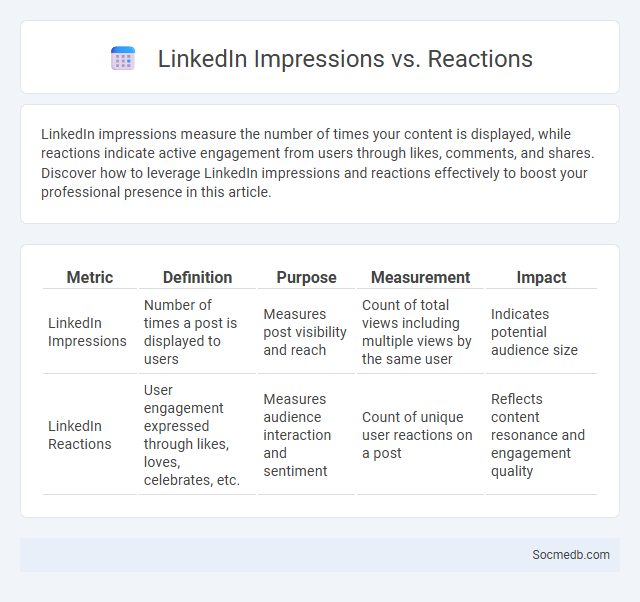
Photo illustration: LinkedIn Impressions vs Reactions
LinkedIn impressions measure the number of times your content is displayed, while reactions indicate active engagement from users through likes, comments, and shares. Discover how to leverage LinkedIn impressions and reactions effectively to boost your professional presence in this article.
Table of Comparison
| Metric | Definition | Purpose | Measurement | Impact |
|---|---|---|---|---|
| LinkedIn Impressions | Number of times a post is displayed to users | Measures post visibility and reach | Count of total views including multiple views by the same user | Indicates potential audience size |
| LinkedIn Reactions | User engagement expressed through likes, loves, celebrates, etc. | Measures audience interaction and sentiment | Count of unique user reactions on a post | Reflects content resonance and engagement quality |
Understanding LinkedIn Impressions: Definition and Importance
LinkedIn impressions represent the total number of times your content is displayed to users, showcasing the visibility and reach of your posts within the professional network. Monitoring LinkedIn impressions helps businesses and professionals gauge audience engagement potential, optimize content strategies, and increase brand awareness among targeted industries. High impression counts correlate with increased opportunities for connections, lead generation, and thought leadership positioning on the platform.
What Counts as a Reaction on LinkedIn?
On LinkedIn, reactions include likes, loves, celebrations, insightful, and curious emojis that users can select to express their feelings towards a post or comment. Each reaction type provides distinct feedback, helping content creators understand audience engagement and sentiment more precisely. Tracking these reactions offers valuable insights into professional interactions and content relevance within LinkedIn's network.
LinkedIn Impressions vs Reactions: Key Differences
LinkedIn impressions measure the number of times your content is displayed on users' feeds, indicating reach, while reactions reflect active engagement, showing how many users interacted with your posts through likes, comments, or other emotive responses. Impressions provide insight into visibility, but reactions offer a deeper understanding of audience interest and content effectiveness. Monitoring both metrics helps optimize your LinkedIn strategy for increased brand awareness and meaningful connections.
How LinkedIn Calculates Impressions
LinkedIn calculates impressions by counting the number of times your post is displayed on users' screens, regardless of whether they engage with it or not. Each impression reflects an opportunity for visibility within your professional network, based on factors like your connections, followers, and the activity of your posts. Understanding how these impressions are measured helps you optimize your content strategy to increase your reach and influence on LinkedIn.
The Impact of Reactions on LinkedIn Engagement
Reactions on LinkedIn significantly influence your content's visibility and engagement by signaling relevance to the platform's algorithm. Positive reactions such as Likes, Celebrations, and Insights increase the likelihood of your post appearing in more users' feeds, driving higher interaction and connection opportunities. Monitoring and encouraging diverse reactions can enhance your professional presence and foster deeper engagement within your LinkedIn network.
Impressions vs Engagement: Why Both Matter
Social media impressions measure the total number of times content is displayed, highlighting brand visibility and reach, while engagement tracks user interactions such as likes, comments, shares, and clicks, reflecting audience interest and connection. High impressions indicate successful content distribution, but without engagement, the impact on brand loyalty or conversions remains limited. Balancing both metrics ensures campaigns not only reach a wide audience but also foster meaningful interactions that drive business growth.
Common Misconceptions about LinkedIn Metrics
Many users mistakenly believe that high follower counts on LinkedIn directly translate to better professional opportunities, but engagement rate and content relevance are more critical metrics for success. People often confuse vanity metrics like likes and views with meaningful actions such as connection requests and profile visits, which drive real networking value. Your focus should be on targeted interactions and quality connections to leverage LinkedIn's potential effectively.
Optimizing Content for Maximum Impressions and Reactions
Optimizing content for maximum social media impressions and reactions involves leveraging engaging visuals, relevant hashtags, and peak posting times tailored to your target audience. You must analyze platform-specific algorithms to enhance content visibility and use interactive elements like polls or questions to boost user engagement. Consistent A/B testing helps refine strategies, ensuring your posts resonate and drive higher reach and interaction rates.
Interpreting LinkedIn Analytics: Best Practices
Interpreting LinkedIn analytics involves analyzing engagement metrics such as likes, comments, shares, and profile visits to gauge content effectiveness. Focusing on key performance indicators like follower growth, click-through rates, and demographic data helps optimize your content strategy for better reach and influence. You can enhance your LinkedIn presence by regularly reviewing insights to tailor posts and connect with your target audience more effectively.
Strategies to Increase LinkedIn Impressions and Reactions
To increase LinkedIn impressions and reactions, focus on crafting engaging content tailored to your target audience's interests and professional needs. Utilize relevant hashtags, post consistently during peak engagement hours, and actively participate in LinkedIn groups to expand your network visibility. You can also encourage interactions by asking thought-provoking questions and responding promptly to comments on your posts.
 socmedb.com
socmedb.com